The lawsuit alleges that city, county, Oklahoma National Guard and other officials created a “public nuisance” by failing to protect the black community in 1921 from white mobs that descended on the affluent Greenwood neighborhood known as Black Wall Street.
Tulsa officials argued that the plaintiffs are seeking damages for injuries suffered outside the two-year statute of limitations.
The Tulsa District Court, where the lawsuit was first filed, ruled against the massacre survivors, but they appealed. In a ruling upholding that ruling, the state Supreme Court wrote on Wednesday that the survivors’ request for relief for “damages resulting from the massacre” did not fall within the scope of the state’s “public nuisance” law.
“The continuing devastation allegedly caused within the Greenwood community by the massacre suggests intergenerational and social inequities that can only be resolved by policymakers, not the courts,” the court wrote.
Lawyers for Fletcher and Rundle said they plan to file a petition asking the court to reconsider the decision. “The murder and arson that destroyed 40 square blocks of land on the night of May 31, 1921 clearly meets the definition of a public nuisance under Oklahoma law,” the lawyers said in a statement.
The lawyers said that as massacre survivors, Randle and Fletcher have a right to justice, and added that they would ask the Department of Justice to open an investigation into the massacre under the Emmett Till Unsolved Civil Rights Crimes Act.
“This lawsuit is not political simply because it seeks to redress the wrongs perpetrated by a white mob against a black person,” the statement said, adding that “the court system is the place where such harm should be remedied.”
The massacre began on the evening of May 31, 1921, when a white mob descended on Greenwood, shooting indiscriminately at black people, and burning over 1,200 homes, a black-owned hospital, and hundreds of black-owned businesses, churches, and schools. Some survivors reported seeing planes dropping turpentine bombs on homes.
The lawsuit filed by the survivors alleges that the city police and sheriff’s department assigned and armed white Tulsan residents to “murder, loot and burn approximately 40 blocks of the Greenwood neighborhood.”
The National Guard “joined this angry white mob in the murder, looting and destruction of property of Greenwood’s black residents,” the lawsuit alleges. “The City, Sheriff, Chamber of Commerce and County targeted black community leaders and victims of the massacre for prosecution as instigators of the massacre, even though they knew who was really responsible.”
Martial law was declared on June 1, 1921. Troops rounded up black survivors at gunpoint and took them to “camps” around the city. Survivors also said they saw black bodies thrown into the Arkansas River or into mass graves. No whites were arrested or charged in the massacre.
In 2018, the city of Tulsa reopened an investigation into whether there were any mass graves from the massacre. In 2020, scientists discovered a mass grave in the city-owned Oak Lawn Cemetery. Scientists are continuing to examine the exhumed remains, testing them for DNA matches to descendants, city officials said.

